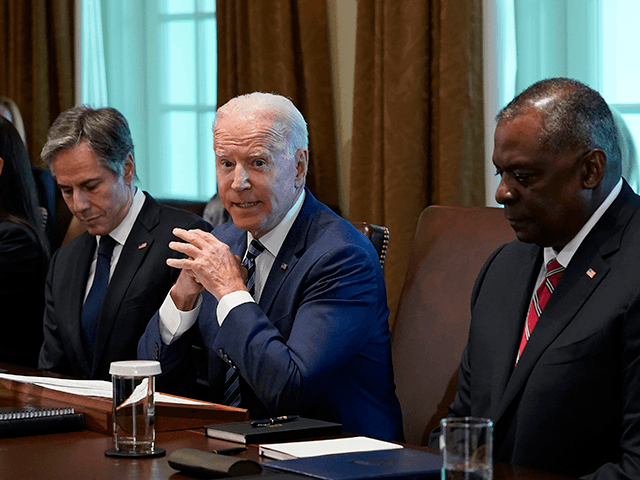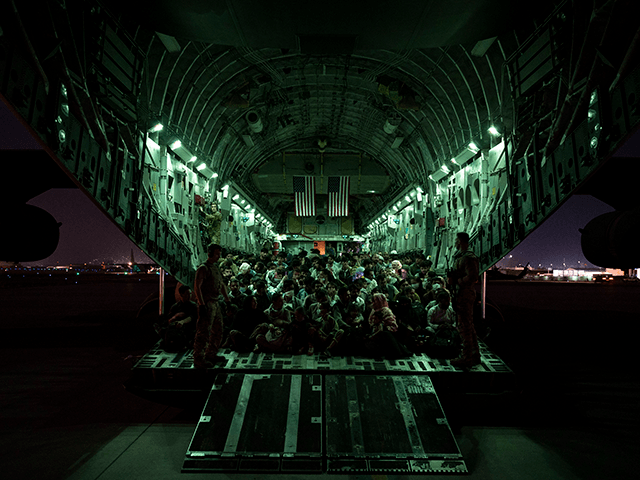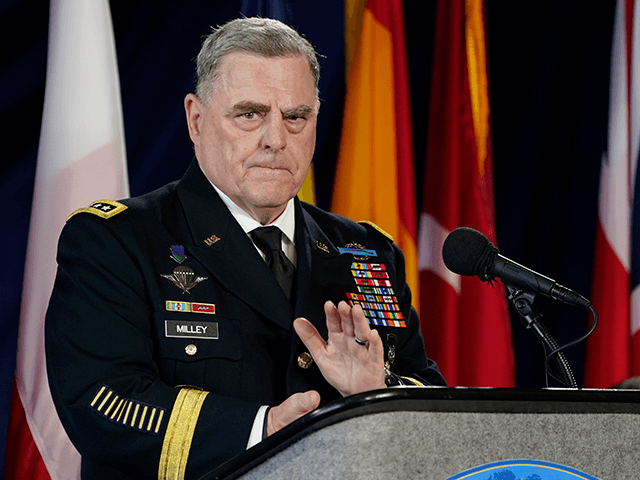The State Department delayed the start of the non-combatant evacuation operation (NEO) aimed at rescuing U.S. citizens and Afghan allies seeking to flee Afghanistan after the Taliban takeover last month, Gen. Mark Milley, the chairman of the Joint Chiefs of Staff, indicated Tuesday.
Whether or not the State Department should have started the evacuation operation sooner instead of nearly two weeks before all American troops left Afghanistan is an “open question that needs further exploration,” Milley testified during a Senate Armed Services Committee hearing on President Joe Biden’s botched U.S. withdrawal.
Citing news reports, Sen. Josh Hawley (R-MO) noted the military wanted to begin evacuations earlier, but the State Department intervened, delaying the NEO.
Asked by Hawley to comment on the accuracy of the reports, Defense Secretary Lloyd Austin said, “We provided input to try to get out as many Afghans who have helped us along the way as, you know, as early as possible. But again, the State Department, as you know, made its decisions.”
Ordering the NEO falls under the purview of the State Department.
Amb. Ross Wilson, the top American diplomat in Afghanistan during the U.S. withdrawal, reportedly delayed issuing the NEO order even after the Pentagon again pushed for the authorization as the Taliban closed in on Kabul, home to the largest concentration of foreigners in Afghanistan.

President Joe Biden speaks during a meeting with his Cabinet in the Cabinet Room at the White House in Washington, Tuesday, July 20, 2021. From left, Secretary of State Antony Blinken, Biden and Secretary of Defense Lloyd Austin. (AP Photo/Susan Walsh)
Ultimately, Amb. Wilson issued the order two days after Defense Secretary Lloyd Austin asked for it, Gen. Milley, the nation’s highest-ranking military officer, noted.
“The secretary [of defense], in fact, on the 12th of August started pushing for forces and orders, and on the 14th, Amb. Wilson called the NEO. Should that have been called earlier? I think that’s an open question that needs further exploration based on a series of meetings,” Gen. Milley told the senators.
Austin told lawmakers that the Pentagon had been ready to evacuate civilians months before the State Department issued the NEO order.
Military officials had already come up with evacuation plans “by late April,” two weeks after Biden announced the complete withdrawal of U.S. troops, the Pentagon chief testified.
Amb. Wilson authorized the evacuation operation a day before the Taliban’s aggressive military blitz culminated with the group sweeping into Kabul and declaring victory on August 15.
Milley stressed that the 2,500 U.S. troops nearly wholly withdrawn from Afghanistan when the Taliban took control of the government would not have been able to carry out the NEO because they were advisers.

Taliban fighters atop a Humvee vehicle take part in a rally in Kabul on August 31, 2021, as they celebrate after the US pulled all its troops out of the country to end a brutal 20-year war — one that started and ended with the hardline Islamist in power. (Hoshang Hashimi/AFP via Getty Images)
“The NEO troops are Marine Expeditionary Units, Special Purpose MAGTAF [Marine Air-Ground Task Force], and elements of the 82nd Airborne Division,” he explained. “That’s what you need in order to do the NEO. Those are the plans that I believe the secretary is referring to that were developed early on.”
Milley noted that his fellow witness at the hearing, Gen. Frank McKenzie, the CENTCOM chief, developed the plans to carry out the NEO, but the military had to wait for Amb. Wilson to call for the evacuation to execute its strategy.
Gen. Milley declared:
There was a plan for a rapid collapse, and that was the NEO plan that Gen. McKenzie had come up with, and that was executed. That’s why those 6,000 troops [that helped evacuate Americans and Afghan allies] could deploy as rapidly as they did. That’s why all those aircraft showed up. That wasn’t done without planning.
President Biden pulled out all U.S. troops from Afghanistan on August 31, ending a two-week-long evacuation effort backed by the 6,000 troops before the State Department could coordinate the withdrawal of all U.S. citizens, lawful permanent residents (LPRs), and Afghan allies.
On Monday, the State Department conceded that roughly 100 American citizens and LPRs remain stranded in Afghanistan, reiterating that the Biden administration does not have a precise tally because the number fluctuates daily.
Milley acknowledged that Biden’s evacuation operation “was a strategic failure,” but he insisted it was a “logistical success.”
“Strategically, the war is lost. The enemy is in Kabul. So you have a strategic failure while you simultaneously have an operational and tactical success by the soldiers on the ground,” he testified. “So I think we’re conflating some things.

In this handout provided by the U.S. Air Force, an aircrew assigned to the 816th Expeditionary Airlift Squadron assists evacuees aboard a C-17 Globemaster III aircraft in support of the Afghanistan evacuation at Hamid Karzai International Airport on August 21, 2021, in Kabul, Afghanistan. (Photo by Taylor Crul/U.S. Air Force via Getty Images)
Echoing other Biden administration officials, Milley indicated that the rapid collapse of Afghanistan took the U.S. by surprise.
The Biden administration “certainly did not plan against a collapse” of the Afghan government in 11 days. However, the fall of Kabul was months in the making, and Milley himself admitted the military had made evacuation plans for the rapid collapse of Afghanistan.
The Taliban launched its successful offensive to take over Afghanistan in early May, soon after Biden announced the complete withdrawal of U.S. troops in April.
Gen. Milley repudiated President Biden’s assertions that “no one” warned him of the potential Taliban takeover. He also refuted Biden’s allegation that top generals, including Milley, did not recommend that he leave behind a residual force in Afghanistan after the withdrawal deadline.

COMMENTS
Please let us know if you're having issues with commenting.